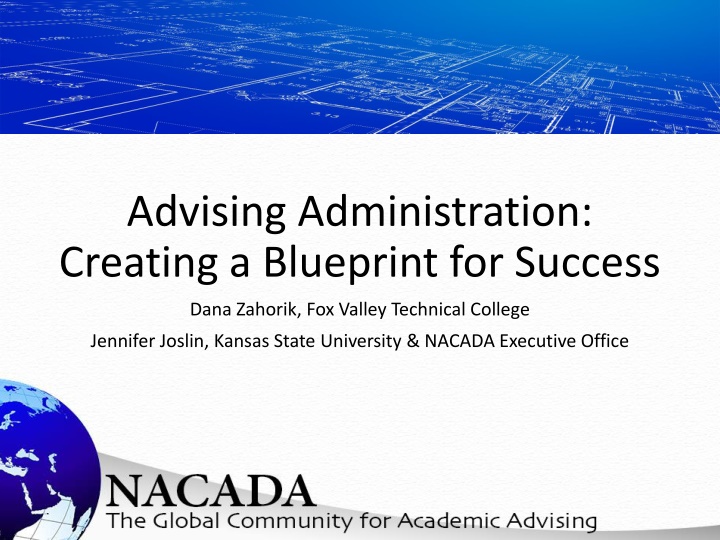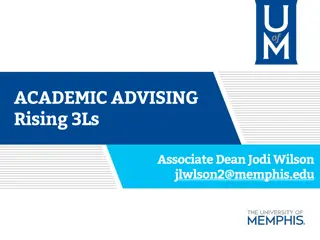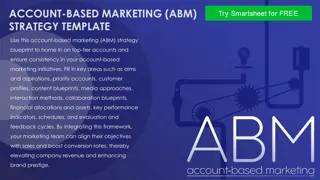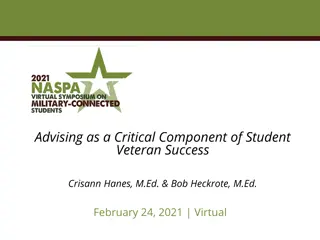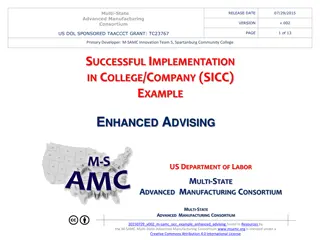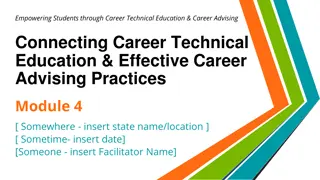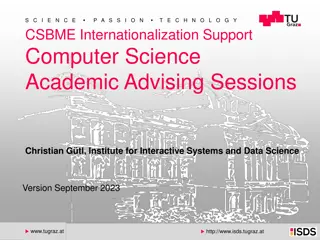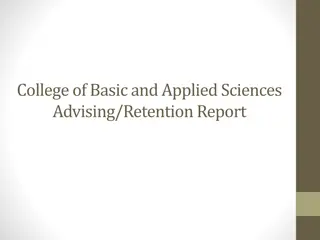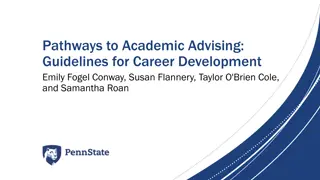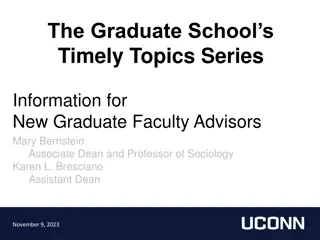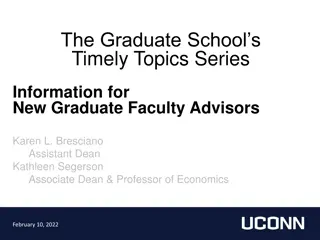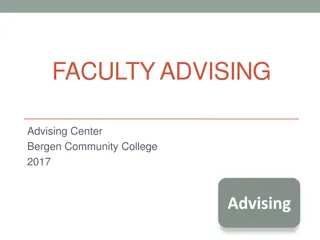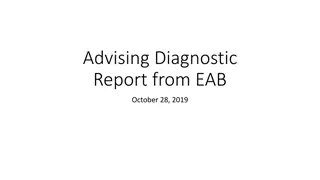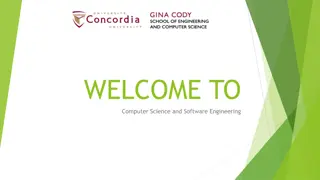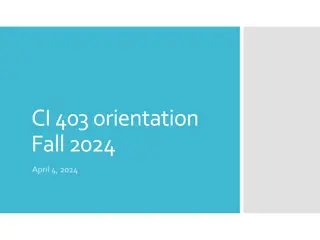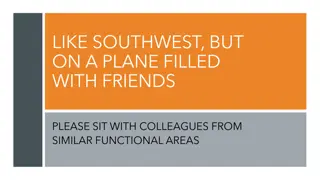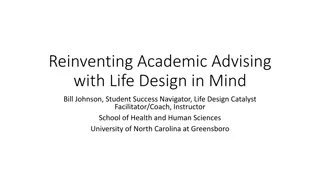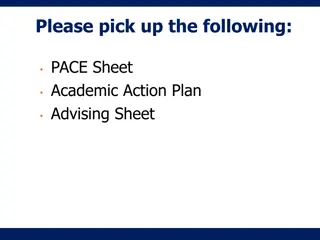Advising Administration: Creating a Blueprint for Success
Delve into the essential components of advising administration, from defining roles to addressing achievement gaps. Explore key strategies for engaging campus-wide advising processes, understanding institutional missions, and fostering healthy advising environments. Gain insights into the differences between leading and managing in this dynamic field. Discover practical approaches for supporting students of diverse backgrounds and creating effective partnerships within academic settings.
Download Presentation

Please find below an Image/Link to download the presentation.
The content on the website is provided AS IS for your information and personal use only. It may not be sold, licensed, or shared on other websites without obtaining consent from the author.If you encounter any issues during the download, it is possible that the publisher has removed the file from their server.
You are allowed to download the files provided on this website for personal or commercial use, subject to the condition that they are used lawfully. All files are the property of their respective owners.
The content on the website is provided AS IS for your information and personal use only. It may not be sold, licensed, or shared on other websites without obtaining consent from the author.
E N D
Presentation Transcript
Advising Administration: Creating a Blueprint for Success Dana Zahorik, Fox Valley Technical College Jennifer Joslin, Kansas State University & NACADA Executive Office
Introductions Name Role at your Institution Years in administration
Shining Moment Share important career moment, accomplishment, or event Take 2-3 minutes to tell your group Dana will ask for 3-4 volunteers to share w/ our large group
Goals for the Day Define the role of an advising administrator Learn differences between conceptual, informational, and relational components relevant to advising administration Practice responding to administrative issues that arise Share effective practices to common administrative issues Create a web of information, allies, and network to support your professional and personal goals
Case of the Achievement Gap, Part I Marcus is in his first year as Director of a small advising office at a community college Office mainly supports undecided students President told him that their institution was concerned about the Achievement Gap affecting Latino/a/x students, Native students, and African- American students
Advising Administration - Defining our Role Engage in the advising process campus wide Know and understand your mission Recognize the campus culture and views on advising Maintain a healthy advising environment Create and maintain a partnership with Student Services and Academic departments Training Supervision, Assessment, and Evaluation Current trends Davis, K. (2008). Advising administrator perspectives on advising. Gordon, Habley, Grites, and Associates. Academic advising: A comprehensive handbook. San Francisco, CA: Jossey-Bass
Leading vs Managing Reference: Alaine Karoleff, PMP, CSM, Agile Project Manager at Civic Actions
Case of the Achievement Gap, Part II Marcus is in his first year as Director of a small advising office at a community college Office mainly supports undecided students President told him that their institution was concerned about the Achievement Gap affecting Latino/a/x students, Native students, and African- American students
The Grid: Conceptual, Informational, & Relational CONCEPTUAL YEAR ONE YEAR THREE & BEYOND Administrator Role & Responsibilities Read key institutional documents about advising Contribute to key documents as committee member or chair Learn unit, department, college position descriptions Develop growth opportunities for staff Recommend any necessary changes to policies or structure(s) affecting advising Learn priorities of upper administrators
The Grid: Conceptual, Informational, & Relational Pick one line in one area Decide whether you need to build initial skills or are ready to build Year Three & Beyond skills Create three Action Steps on the attached hand-out to achieve competency and/or develop skills
Case of the Achievement Gap, Part III Marcus is in his first year as Director of a small advising office at a community college Office mainly supports undecided students President told him that their institution was concerned about the Achievement Gap affecting Latino/a/x students, Native students, and African- American students
Cheerleader Administration Mentor Challenger Mentor/Ally Writing Mentor Presentation Pal Mentor/Ally Mentor/Ally YOU! Network of Awesome Campus Mentor Fitness Buddy Mentor/Ally Mentor/Ally Professional Development Buddy NACADA Mentor
Strategies for Effective, Efficient, Collaborative Meetings Identify the 7 Sins of Deadly meetings Understand Salvations for the 7 Sins Knowing What Success Looks Like Utilizing Meeting Management Systems References: We ve Got to Stop Meeting Like This! George Lowe and Tony Jeary The Seven Sins of Deadly Meetings Eric Matson
Meeting Realities Is lack of focus or digression from the subject a problem in the meetings you attend? Have you attended a meeting recently that created more problems than it solved? Do you and your team spend a lot of time in meetings (and would like to spend less time while accomplishing more)? Have you ever found it hard to get a word in edgewise or felt like putting a gag on someone who dominated a meeting?
7 Sins of Deadly Meetings 1. People don't take meetings seriously 2. Meetings are too long 3. People wander off the topic 4. Nothing happens once the meeting ends 5. People don't tell the truth 6. Meetings are always missing important information, so they postpone critical decisions 7. Meetings never get better - People make the same mistakes
Success Goals were set and a detailed agenda was planned Only those needed were invited Ground rules were agreed upon Everyone was involved Areas of agreement were sought Accomplishments were recapped Participants were reminded of agreed-upon responsibilities
Meeting Management System Templates Meeting Considerations Worksheet Meeting Preparation Checklist Meeting Announcement and Agenda Meeting Agreements and Assignments
Time Management Hacks GTD or Get Things Done by David Allen (also see Cal Newport s blogs and posts: http://www.calnewport.com) #inboxzero email management that works Doodle for scheduling meetings Moleskine for classic capture devices notebooks Headspace for meditation (no, really, it works!) Task Timer to keep on track Google Scholar for research NACADA for professional development! Ideas courtesy of Jeannette Passmore, James A. Rhodes State College
Time Management Hacks Allen, D. (2002). Getting things done: The art of stress-free productivity. New York, NY: Penguin Books. Guinness, H. (2014, September). 5 action steps for curing your inbox zero email frenzy. Retrieved from http://www.makeuseof.com/tag/5-action- steps-curing-inbox-zero-email-frenzy/York, NY: Penguin Books. Hamberg, E. (n.d.) GTD in 15 minutes A pragmatic guide to getting things done. Retrieved from http://hamberg.no/gtd/#processing-the-in-list Newport, C. (2009, March 30). 4 weeks to a 4.0: Adopt an autopilot schedule and a Sunday ritual. Retrieved from http://calnewport.com/blog/2009/03/30/4-weeks-to-a-40-adopt-an- autopilot-schedule-and-a-sunday-ritual/ From Jeannette s AAT article: Passmore, J. (2015, June). Getting things done. Academic Advising Today, 38(2). Retrieved from https://www.nacada.ksu.edu/Resources/Academic-Advising-Today/View-Articles/Getting-Things- Done.aspx
Final Thoughts Dana Zahorik: zahorik@fvtc.edu Jennifer Joslin: jejoslin@ksu.edu
